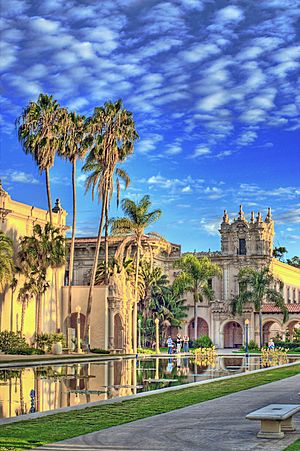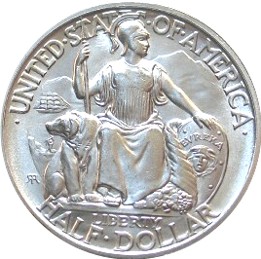California Pacific International Exposition facts for kids

Balboa Park, site of the California Pacific International Exposition, in San Diego
|
|
Quick facts for kids Overview |
|
|---|---|
| BIE-class | Unrecognized exposition |
| Name | California Pacific International Exposition |
| Specialized expositions | |
The California Pacific International Exposition was a huge fair held in San Diego, California. It took place from May 29 to November 11 in 1935, and then again from February 12 to September 9 in 1936.
This big event happened in Balboa Park. This is a large central park in San Diego. The park had also hosted another fair, the Panama–California Exposition, back in 1915.
The main goal of the Exposition was to help San Diego. The city's economy was struggling during the Great Depression. The fair was a big success in its first year. So many people visited and it made enough money that they decided to open it for a second year.
The Exposition featured hundreds of displays. These included exhibits about history, art, plants, different cultures, science, and industries. Some of the attractions were quite unique. For example, there was the Gold Gulch, the Lost Continent of Mu, and a giant "One Ton Mechanical Man."
Contents
How the Fair Started
The idea for this fair came from a man named Frank Drugan. He moved to San Diego in 1933. He noticed the buildings in Balboa Park that were left over from the 1915 fair. These buildings were meant to be temporary, but they had been fixed up and improved.
Frank Drugan also knew that the "Century of Progress" fair in Chicago was ending. Many of its exhibits could be moved to San Diego. The Chicago fair had earned enough money to pay for itself. Drugan believed a San Diego fair could do the same.
He told local business people his idea. He suggested using the old buildings and adding new ones. He said it would help San Diego's economy. They agreed to support the plan.
The Exposition company officially started in August 1934. Building new structures began in January 1935. Workers rushed to get everything ready for the May opening. Some building foundations were laid even before the final plans were finished.
In March and April, 2,700 people worked day and night on the fair. About 65% of these workers were paid by the government. This was part of a program to help people find jobs during the Depression. The rest were employees of private companies.
Fun Exhibits and Shows
The Exposition had many interesting exhibits. One popular one was The Hollywood Motion Picture Hall of Fame. This exhibit featured actors who were part of the Screen Actors Guild. It also included members of The Dominos Club of Hollywood, a social group for actresses like Carole Lombard and ZaSu Pitts.
Amazing Architecture
The buildings from the 1915 fair were built in a style called Spanish Colonial Revival architecture. Architects Bertram Goodhue and Carleton Winslow designed them. For the 1935 fair, architect Richard Requa designed new permanent buildings.
Requa wanted his designs to connect old Native American buildings and temples from the Southwest and Mexico with modern times. He used the 1915 New Mexico Building as a model. He changed it into a Palace of Education. Many new large buildings followed this style. These included the California State Building (now the San Diego Automotive Museum) and the Palace of Electricity (now a gym).
Other new buildings and areas included:
- The Old Globe Theatre: This was a copy of a theater from the Chicago fair. That theater was a copy of the original Globe Theatre in London. During the Exposition, it showed short versions of plays by William Shakespeare. After the fair, it was changed and roofed. It continued to show plays. The building burned down in 1978 but was rebuilt. Now, it's part of a three-theater complex.
- The circular Ford Building: Many people thought this was the most amazing building at the fair. Today, it is home to the San Diego Air & Space Museum.
- The Ford Bowl: This is now called the Starlight Bowl. It's an outdoor theater used for concerts and shows.
- The House of Pacific Relations: This is a group of fifteen small cottages with red-tiled roofs. Each cottage was for a different country. These "International Cottages" are still used today by groups from 32 countries. They host educational events and international festivals.
- Spanish Village: This was a group of six buildings with shops, restaurants, and a children's theater. It is now the Spanish Village Art Center. It has 37 art studios and galleries where artists work.
The gardens from the 1915 fair were also changed. They went from formal designs to lush gardens filled with many exotic plants. Richard Requa, influenced by gardens he saw in Spain, redesigned many of them. Today, the Alcazar garden, Zoro Garden, and the garden at Cafe del Rey Moro are all Requa's designs.
Special Coins and Stamps
To celebrate the California Pacific International Exposition, the U.S. government made a special silver half dollar coin.
A three-cent postage stamp was also released. It showed a view of the fairgrounds. It had the same words as the back of the half dollar coin. It also included the dates "1535 1935". Over 100 million of these stamps were printed, so they are very common.
Fair Facts and Figures
The Exposition took ten months to build. It welcomed 7,220,000 visitors during its 377 days of operation. Visitors spent about US$37.7 million in San Diego. The fair itself cost US$20 million to put on.
Admission was 50 cents for adults. It was 25 cents for children aged 2 to 11. There were four restaurants: Cafe of the World, Palisades Cafe, Spanish Kitchens, and the Pioneer Days Restaurant.
Twenty-one nations took part in the fair. These included Argentina, the British Empire, China, Germany, Italy, Japan, and the United States.
What Lasted from the Fair
The park got US$6 million worth of improvements. The fair was so popular that some buildings were rebuilt to be more permanent. Many of these buildings, or new versions of them, are still used today. They house several museums and theaters in Balboa Park.
In the early 1960s, some of the fair buildings were torn down. New buildings were put up that looked very different. This made many people in San Diego upset. A group called the 'Committee of One Hundred' was formed. They wanted to protect the park buildings.
The Committee convinced the City Council to make a rule. Now, any new buildings in the park must be built in the Spanish Colonial Revival Style. The Committee also worked to have the remaining original buildings declared a National Historic Landmark. This happened in 1978. In the late 1990s, buildings that were very old or had burned were carefully rebuilt. This helped restore the park's original look.
In October 2010, the National Building Museum in Washington, D.C. opened an exhibit. It was called Designing Tomorrow: America's World's Fairs of the 1930s. This exhibit featured the California Pacific International Exposition.


